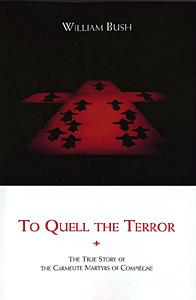
A Review of: To Quell the Terror, by William Bush
There are times when history is seen from an all-too-human perspective.
Granted, man is the principal agent in history. His great deeds and misdeeds fill the history books, blending fact, myth, and legend to intrigue future generations.
However, man is not the only agent. There are times when men perform acts so sublime that yet another agent enters. In these cases, men move God to act in history — and these feats capture the imagination and are immortalized for all times.
Such a thesis fares ill among today’s secular historians. They would prefer to explain away history in a thousand other ways. Nevertheless, this is William Bush’s compelling thesis in his 1999 book To Quell the Terror: The Mystery of the Sixteen Carmelites of Compiègne, Guillotined July 17, 1794.
Uncovering History
Professor Bush’s story could not be more dramatic. It is set at the height of the French Revolution’s “Great Terror.” Sixteen Carmelite nuns were martyred at the guillotine while praising the glory of God in song and hymn, thus setting themselves apart from thousands who shared a similar fate.
No one disputes the fact that the story of these Compiegne martyrs — Blessed Thérèse of St. Augustine and companions — captured the popular imagination, even among non-Catholics. Fictional representations of their story were retold in Gertrude von Le Fort’s novella Song of the Scaffold and Francis Poulenc’s opera Dialogues of the Carmelites.
Learn All About the Prophecies of Our Lady of Good Success About Our Times
However, William Bush, professor emeritus of French literature at Canada’s University of Western Ontario, delves yet deeper into this sublime event, developing a theme that cannot but leave the reader in captivating awe.
Mugged by historical reality, Professor Bush likewise goes beyond the popular myth of a “good” French Revolution turned bad. Rather, he sees it for what it was: the beginning of a radical new order that overthrew “the ancient pact between France’s kings and Christianity’s triune God.”
Beyond Fiction
Fiction often manages to embellish reality, the writers taking liberties that highlight the dramatic and obscure the imperfect. Ironically, Professor Bush’s meticulous research of the Carmelite archives does the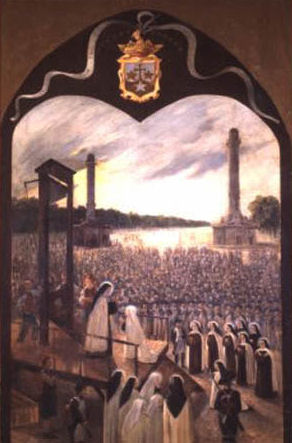 opposite. The facts he uncovers reveal the poverty of the fiction.
opposite. The facts he uncovers reveal the poverty of the fiction.
The literary representations of the Carmelites’ story were made to satisfy secular audiences. The fictitious Blanche de la Force, von le Fort’s vacillating nun afraid to face her martyrdom, stressed the all-too-human perspective where personal drama eclipsed the supernatural calling of these nuns who moved God to act in history.
Thus, Professor Bush succeeds where others have failed. He pierces the supernatural mystery of the Carmelites’ martyrdom. He recounts how the nuns, moved by grace, took upon themselves a task so daring as to seem impossible: They intended to save France.
A Sublime Offering
What history reveals is indeed sublime.
For a full twenty months before their execution, the sisters came together in an act of consecration “whereby each member of the community would join with the others in offering herself daily to God, soul and body in holocaust to restore peace to France and to her Church.”
The nuns were not just mere victims of the Revolution overcome by circumstances. Contrary to the fiction, each contemplated her martyrdom; each understood her offering. Each sought that “greater love” of giving herself for her fellow man in imitation of the Divine Lamb Who redeemed humanity.
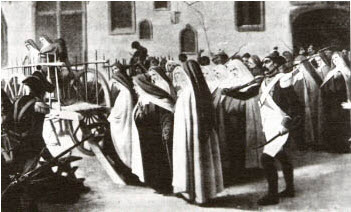
A Tale of Courage and Holiness
Professor Bush recounts the complete story of each of the sixteen Carmelites, relating in lively detail virtually all that is known of their lives and backgrounds.
Each story is in itself a drama as varied as the personalities involved. There was the strong Mother Thérèse of Saint Augustine, a maternal woman of courage and character who led her daughters to martyrdom.
There was 74-year old Sister Jesus Crucified who, despite her age, endured all. Sister Julia Louise was a poet and painter who composed a parody of the Marseillaise. The impulsive and philosophical Sister Euphrasie on her way to the guillotine passed her office book to a young girl, who later became a nun.
There was the young unprofessed Sister Constance, forbidden by the Revolution to make her final vows. She did finally take her vows at the foot of the scaffold, where her first and last act as a professed Carmelite was to ask permission to die.
These and all the other nuns, lay sisters, and even two hired extern sisters endured harassment, expulsion, suppression, and insult at the hands of the Revolution. And their story, told by Professor Bush, is a chronicle of sublime deeds aimed at moving God.
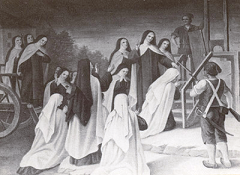
A Sacrifice Accepted
Perhaps the most impressive part of the Carmelite story is that God was actually moved. Indeed, their arrest, trial, and execution represented not a Catholic defeat but a triumph.
In a courtroom once used by Saint Louis himself, the nuns defended themselves with valor before a Revolutionary tribunal, yet they were condemned to death before nightfall.
The news of their impending death was received with great happiness. It is related that as they waited to be boarded on the tumbrels, the Carmelites joyfully sang Sister Julia’s parody of the Marseillaise, defiantly forcing the Revolutionary hymn to proclaim:
“Let’s climb, let’s climb the scaffold high!
“Let’s give God the victory!”
No one jeered and hooted at the nuns as they went to the place of execution. Rather, an eerie silence surrounded the cortege as the nuns continued their song. Naught was heard but the “austere chant of high solemn joy” of those who, after some twenty months of consecrating themselves each day for this hour, God’s mercy allowed them to make this final act of holocaust. Each nun knelt before the prioress, renewed her vows, kissed a tiny terracotta statuette of Madonna and Child, and then mounted the scaffold high.
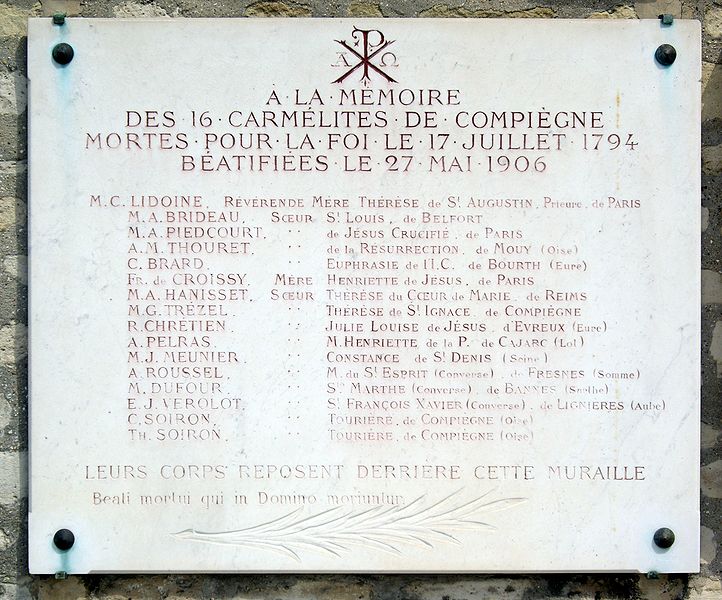
To Quell the Terror
Ten days after their deaths, Robespierre fell and the Reign of Terror effectively ended. Skeptical historians may scowl at making this connection, but it is hard to deny that the final acts of their death touched a profound chord.
Something in the very foundation of the edifice of the French Revolution was shaken by the nuns’ defiant and joyful gesture. The eerie silence around the scaffold presaged the regime’s fall from power.
Professor Bush concludes that God manifested Himself in this martyrdom, which he claims frustrated the Revolution’s attempt to annihilate France’s “ancient pact” with God.
In a secular epoch, which excludes God from history, To Quell the Terror leaves the reader with the conviction that while man may abandon God, God does not abandon man. Come what may, God inspires His Church to act in history with astonishing power and results.
The book begs the question. If today, God is not moved to act in history to deliver man from the iniquities of the modern world, perhaps it is because there are none to quell the modern day terror, none who dare offer themselves as victims to abate the raging storm.
Excerpts from Sister Julia’s parody of the Marseillaise
Let our hearts be giv’n to joyfulness
The day of glory now is here!
Let us banish all of our weakness,
We can see that the cross now is near! (repeat)
Let’s prepare ourselves for the victory!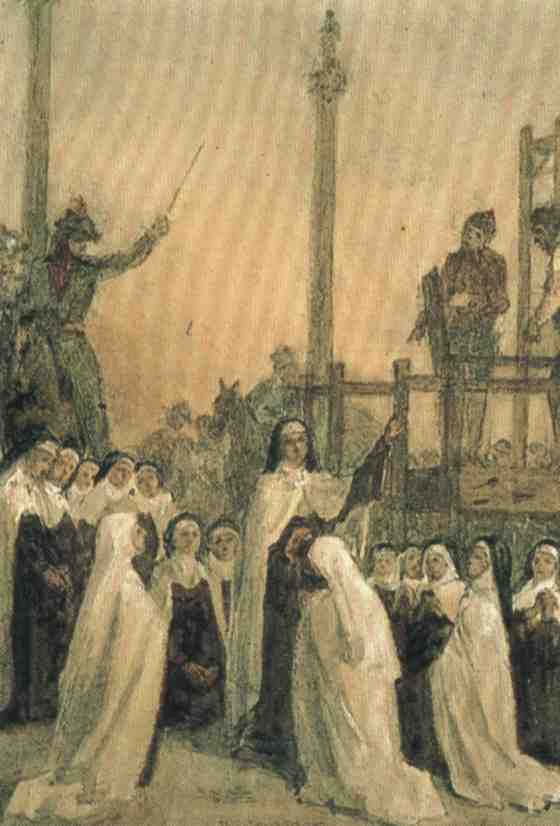
Let us each as a conqueror go forth!
Under the cross, God’s great banner.
Let’s all run, let’s all fly toward glory!
Let our ardor be enflamed!
Let’s give our bodies in his Name!
Let’s climb, let’s climb, the scaffold high!
We’ll give God the victory!
Happiness that’s ever beckoning
To all the Catholics of France
To take up the path of the martyrs
Where many another’s advanced! (repeat)
The martyrs go off to their passion
As did Jesus, followed by our king.
Our faith as Christians let us bring,
God’s righteousness let us adore!
So let the priest with zeal,
And all believers seal,
Their faith, their faith, with all their blood,
In a God who like them died.
Great God who seest all my weaknesses
Although I’m eager, still I fear.
Confidently ardor now guides me,
O do thou lend thine aid and be near! (repeat)
Holy Virgin, our example.
Of martyrs all the august Queen.
Do thou deign to sustain our great ardor
Cleanse our desires, make us all pure and clean! (repeat)
To Quell the Terror: The Mystery of the Sixteen Carmelites of Compiègne, Guillotined July 17, 1794
By William Bush
Paperback – (November 1999)
ICS Publications
ISBN: 0935216677
$11.95
Published in Crusade Magazine, Vol.49, January-February, 2001, pp. 20-21.
Last updated on July 17, 2018.
